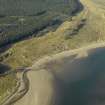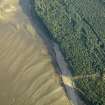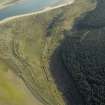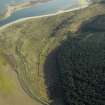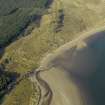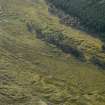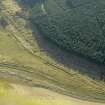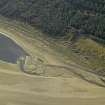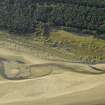Tentsmuir Forest
Anti Tank Blocks (20th Century)
Site Name Tentsmuir Forest
Classification Anti Tank Blocks (20th Century)
Alternative Name(s) Tentsmuir Coastal Defences; Tentsmuir Sands
Canmore ID 84192
Site Number NO52NW 7
NGR NO 5054 2730
NGR Description NO 5045 2700 to NO 5000 2778
Datum OSGB36 - NGR
Permalink http://canmore.org.uk/site/84192
- Council Fife
- Parish Ferry-port-on-craig
- Former Region Fife
- Former District North East Fife
- Former County Fife
NO52NW 7 5045 2700 to 5000 2778
For rest of line of Anti-Tank blocks, see also NO52NW 10
For other military command, training and defensive structures on Tentsmuir Sands, see also:
NO42NE 71-3, 117 and 127
NO42SE 56-7, 77-9 and 81
NO52NW 1-6 and 8, and NO52SW 1.
A single row of anti-tank blocks run the full length of the beach to the E of Tentsmuir Forest. Some of the blocks are buried in the sand.
J Guy 1994; NMRS 810/3, 147
NGR not given, the world war 2 anti tank blocks are described as continuous along coast of Tentsmuir. This site was recorded as part of an archaeological evaluation of Forestry Commission land in Tentsmuir, Fife carried out by Headland Archaeology Ltd. This evaluation was commissioned by Fife Council Planning Service in advance of Forest Enterprise felling proposals, the work was executed to a brief prepared by Peter Yeoman and Sarah Govan of Fife Council Archaeological Service. A continuous line of anti-tank blocks was constructed on the coast of Tentsmuir in 1940. It is now partially washed away and considerable lengths appear to be buried by sand. The main visible sections lie outside Forestry Commission land but the report concludes that it must survive in part on Commission land. The blocks were constructed as the low sandy coastline of Tentsmuir was considered to be a high risk from a sea-borne invasion and the Leuchars airfield also required protection from attack. There is a concentration of observation posts, command posts, pillboxes and other structures behind the continuous line of anti-tank blocks. The density of these structures is highest at the S end of Tentsmuir, closer to Leuchars. There is deep water here close into the shore so the risk of attack was greatest. These sites were manned by Polish Units who lived in a camp in the forest.
Sponsors: Fife Council with support from Historic Scotland and Forest Enterprise
NMRS MS/889/32 (May 1997 Headland Archaeology Ltd)
NO 4648 2633 This report gives an overview and synthesis of the archaeology of Tentsmuir, it should be read in conjunction with MS/899/32 which gives more detail on the archaeological evaluation Headland Archaeology Ltd conducted in the area. The report contains the sections 'The Scope and Aims of the report', 'The geomorphic evolution of Tentsmuir', 'History of archaeological investigation'. It then goes on to look at the archaeology of Tentsmuir, period by period : 'Mesolithic', 'Later prehistoric', 'Medieval and post Medieval', 'Agricultural improvement' amd finally 'World War Two'. Maps and plans for each period are also included.
Sponsors: Fife Council with support from Historic Scotland and Forest Enterprise.
NMRS MS/899/33 (May 1997 Headland Archaeology Ltd.).
Part of a continuous line of concrete anti-tank blocks which formerly extended along the coast at just above the high water mark. They are visible on vertical air photographs (106/Scot/UK33 4075-4077, flown 25 April 1946) along with several of the pillboxes on the coastal crust defence line at Tentsmuir Forest.
Information from RCAHMS (DE), November 2007.
Publication Account (2009)
The website text produced for Tentsmuir webpages on the Forest Heritage Scotland website (www.forestheritagescotland.com).
Introduction: The Lion and the Eagle
Polish Forces, based in Scotland, constructed the World War II defences], whose remains are still evident on Tentsmuir beach and hidden within Tentsmuir forest.
The sandy beaches at Tentsmuir would have made an ideal landing location for German invasion troops in 1940. The coast needed defending.
Polish Forces and locals built a system of linear defences as part of the overall plan to protect Britain from enemy invasion. The defences ran north from Leuchars Airfield, also a prime target for attack, to Lundin Bridge.
They included lines of concrete anti-tank blocks, observation towers and pillboxes, all designed to slow down enemy movement inland.
Long, wooden poles stood upright along the coastline to prevent enemy gliders from easily landing behind defence lines. At low tide, some of these poles are still visible at Tentsmuir beach.
The Polish soldiers constructed and lived in a camp at Tentsmuir forest. Once they had constructed the defences, many remained to man the guns and patrol the area.
Today little remains of the dismantled camp where the Polish soldiers lived. Look closely, however, and impressed in the concrete wall of an old well you can find the coat of arms of the Polish Army, a lion and an eagle. This survives as a reminder of the Poles who defended the beaches of Fife.
People Story: Polish stories of World War II
Many Polish soldiers came to help defend the coast of Fife. Their stories tell a little of what life was like under the threat of enemy invasion.
Prior to the construction of the defences at Tentsmuir, Wieslaw Szczygiel's Polish Engineer unit came to Tentsmuir Forest to build a camp. Later, this served as a home for other Polish soldiers who would build and man the defences.
The rainy Scottish weather often delayed the construction of the camp. Wieslaw remembers long hours, under tent cover, chatting and smoking.
Wieslaw also recalls day trips to St Andrews' Tudor cafe for a traditional British fry up. Ration portions were small so they would have breakfast, go to the pub, and return to the cafe in the afternoon for a second helping.
Stationed at Tentsmuir to build the defences, Tadeusz Apfel-Czaszka remembers the importance of their task.
"Here our job was to guard against the expected German invasion which we firmly believed would come. We built blockhouses and concrete obstacles, defended the coast with our French machine guns and trained"
Captain Tadeusz Apfel-Czaszka in Henderson's(2001) "The Lion and the Eagle"
Both these men share a similar story to many Poles. They escaped from Poland and fought elsewhere in Europe before arriving in Scotland. After the war ended, they settled in Scotland.
Thanks to the Scots at War Trust for collecting these wartime accounts.
Evidence Story: Examining the evidence: anti-tank blocks
The construction of the defences along the east coast of Scotland was a major task.
Personal accounts from Polish soldiers provide some detail about building the anti-tank blocks.
Dr Kazimierz Piotr Durkacz was a third year medical student in Poland when Germany invaded in 1939. He joined the Polish Forces and ended up in Scotland. Durkacz worked north of Tentsmuir on the coastal defences from Broughty Ferry to Arbroath. He describes building the anti-tank blocks.
"At first we used wood to make the mould for the large concrete blocks and then a combination of corrugated iron and wood. I can remember mixing the concrete with a shovel."
Dr Kazimierz Piotr Durkacz in Henderson's(2001) "The Lion and the Eagle"
Once the concrete set, they removed the wooden mould.
The soldiers worked in squads of ten men. Their squad leader would tell them where to place the double rows of blocks. Each squad had a target of blocks to complete in a week.
The soldiers built the anti-tank blocks either in situ or transported to a location. One sign of the latter would be an iron ring on the top. The blocks were heavy and a winch lifted them into place.
Some blocks had pebbles set into the concrete while they were still wet, this provided camouflage on a pebble beach. Others have the initials of the person who made them drawn into the concrete.















